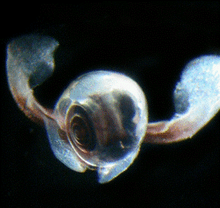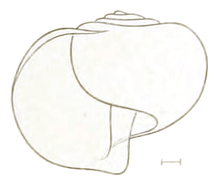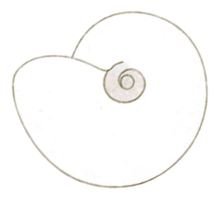Limacina rangii
| Limacina rangii | |
|---|---|
 | |
| Limacina rangii | |
| Scientific classification | |
| Kingdom: | Animalia |
| Subkingdom: | Metazoa |
| Phylum: | Mollusca |
| Class: | Gastropoda |
| (unranked): | clade Heterobranchia clade Euthyneura |
| Superfamily: | Limacinoidea |
| Family: | Limacinidae |
| Genus: | Limacina |
| Species: | C. rangii |
| Binomial name | |
| Limacina rangii Woodward, 1854[1] | |
| Synonyms | |
| |
Limacina rangii is a species of swimming sea snail in the family Limacinidae,[2] which belong to the group commonly known as sea butterflies (Thecosomata).
Limacina rangii is a keystone species of the mesozooplankton of Antarctic pelagic ecosystems.[3]
Until 2010 this taxon was known only as Limacina helicina antarctica or as Limacina helicina f. antarctica. Limacina rangii is however now considered to be a separate species from Limacina helicina, based on cytochrome c oxidase subunit I (COI) gene sequences.[4]

Distribution
The distribution of Limacina rangii is circumglobal south of 50°S.[5]
This species occurs in the Weddell Sea[6] and Ross Sea in the Antarctic[7] and in Cumberland Bay, South Georgia.[8] and other localities in the Southern Ocean.
Description
Limacina rangii has a sinistral and very thin shell.[3] Its thickness is approximately 2–9 μm.[3] There are ribs on the surface of the shell.[3] There are differences in the shell structure between Limacina rangii and Limacina helicina.[3]
The width of the shell is 0.5-6 mm.[3]
 Apertural view. |
 Umbilical view. |
Ecology
Limacina rangii is a holoplanktonic species. It is very abundant in the Southern Ocean, with up to 2681 individuals per m3.[9] This species is abundant in the Ross Sea, Antarctica.[10] It is sometimes even more abundant than krill.[10][11]
Limacina rangii feeds mainly on phytoplankton and also on zooplankton, but less so.[10] It catches its prey using mucus webs.[10]
This snail is a primary consumer and directly depends on phytoplankton.[10] When the phytoplankton is reduced, the population of Limacina rangii is also reduced,[10] and it can even disappear as happened in McMurdo Sound in the summer of 2000-2001.[10] It is considered an indicator species of the health of the ecosystem.[10] Under different conditions in McMurdo Sound there can be over 300 individuals per m3, which is over 20% of the biomass of zooplankton.[10]
Fecal pellets of Limacina rangii and its quantity have been firstly described by Manno et al. (2010).[12] Fecal pellets are oval, greenish brown and with peritrophic membrane.[12] A size of a single pellet varies from 103 μm (286600 μm3) to 120 μm (440,610 μm3).[12] A single Limacina rangii produces about 6-11 pellets daily.[12] Population of Limacina rangii in the studied area in the Ross Sea produced from about 71,000 pellets per square meter per year to about 362,000 pellets per square meter per year.[12] Fecal pellets of Limacina rangii has contributed to about 19% of flux of organic carbon.[12] Fecal pellets of Limacina rangii together with dead Limacina rangii can cover up to 72% (estimation) of organic carbon flux to the deep water.[12]
Limacina rangii probably affect carbon cycle, resources of phytoplankton and dimethyl sulfide (emission by phytoplankton), that may have impact on the Earth's climate.[10]
Many[10] predators depend on Limacina rangii as their food source:
- The gastropod Clione antarctica feeds only on Limacina rangii.[13][10] There is a coevolutionary relationship between this specialized predator and its prey; their life cycles are parallel.[10]
- The medusae Solmundella bitentaculata[14] and Diplulmaris antarctica[14]
.gif)
- Fish in the family Myctophidae heavily depend on Limacina rangii.[10] Limacina sp. is a food species for a number of myctophid fishes in the Southern Ocean: Electrona antarctica, Electrona paucirastra, Electrona subaspera, Metelectrona herwigi, Protomyctophum normani, Diaphus taaningi, Diaphus hudsoni, Gymnoscopelus nicholsi, Ceratoscopelus warmingii and Symbolophorus boops.[15]
- Also notothenioid fish (family Nototheniidae) heavily depend on Limacina rangii as food.[10] For example fishes: Trematomus newnesi,[16] Trematomus bernacchii, Trematomus hansoni, Trematomus centronotus and Pagothenia borchgrevink.[17]
- Whales heavily depend on this species[10]
References
- ↑ Woodward S. P. (1854). A manual of the Mollusca; or, A rudimentary treatise of recent and fossil shells. 2: 207. London. Plate 14, figure 41.
- ↑ Bouchet, P. (2014). Limacina rangii (d'Orbigny, 1834). Accessed through: World Register of Marine Species at http://www.marinespecies.org/aphia.php?p=taxdetails&id=719583 on 2015-01-24
- 1 2 3 4 5 6 Sato-Okoshi, W.; Okoshi, K.; Sasaki, H.; Akiha, F. (2010). "Shell structure of two polar pelagic molluscs, Arctic Limacina helicina and Antarctic Limacina helicina antarctica forma antarctica". Polar Biology. 33 (11): 1577. doi:10.1007/s00300-010-0849-1.
- ↑ Hunt, B.; Strugnell, J.; Bednarsek, N.; Linse, K.; Nelson, R. J.; Pakhomov, E.; Seibel, B.; Steinke, D.; Würzberg, L. (2010). Finkel, Zoe, ed. "Poles Apart: The "Bipolar" Pteropod Species Limacina helicina is Genetically Distinct Between the Arctic and Antarctic Oceans". PLoS ONE. 5 (3): e9835. doi:10.1371/journal.pone.0009835. PMC 2847597
 . PMID 20360985.
. PMID 20360985. - ↑ "Limacina helicina antarctica antarctica". Marine Species Identification Portal, accessed 9 February 2011.
- ↑ Linse, K.; Brandt, A.; Hilbig, B.; Wegener, G. (2004). "Composition and distribution of suprabenthic fauna in the south-eastern Weddell Sea and off King George Island". Antarctic Science. 14. doi:10.1017/S0954102002000512.
- ↑ Accornero, A.; Manno, C.; Esposito, F.; Gambi, M. C. (2003). "The vertical flux of particulate matter in the polynya of Terra Nova Bay. Part II. Biological components". Antarctic Science. 15 (2): 175. doi:10.1017/S0954102003001214. PDF.
- ↑ Ward, P. (2004). "The distribution of zooplankton in an Antarctic fjord at South Georgia during summer and winter". Antarctic Science. 1 (2). doi:10.1017/S0954102089000210.
- ↑ Comeau, S.; Gorsky, G.; Jeffree, R.; Teyssié, J. -L.; Gattuso, J. -P. (2009). "Impact of ocean acidification on a key Arctic pelagic mollusc (Limacina helicina)". Biogeosciences. 6 (9): 1877. doi:10.5194/bg-6-1877-2009.
- 1 2 3 4 5 6 7 8 9 10 11 12 13 14 15 16 Seibel, B. A.; Dierssen, H. M. (2003). "Cascading trophic impacts of reduced biomass in the Ross Sea, Antarctica: Just the tip of the iceberg?". The Biological bulletin. 205 (2): 93–97. doi:10.2307/1543229. PMID 14583506.
- ↑ Orr, J. C.; Fabry, V. J.; Aumont, O.; Bopp, L.; Doney, S. C.; Feely, R. A.; Gnanadesikan, A.; Gruber, N.; Ishida, A.; Joos, F.; Key, R. M.; Lindsay, K.; Maier-Reimer, E.; Matear, R.; Monfray, P.; Mouchet, A.; Najjar, R. G.; Plattner, G. K.; Rodgers, K. B.; Sabine, C. L.; Sarmiento, J. L.; Schlitzer, R.; Slater, R. D.; Totterdell, I. J.; Weirig, M. F.; Yamanaka, Y.; Yool, A. (2005). "Anthropogenic ocean acidification over the twenty-first century and its impact on calcifying organisms". Nature. 437 (7059): 681–686. doi:10.1038/nature04095. PMID 16193043. PDF. (author's draft).
- 1 2 3 4 5 6 7 Manno, C.; Tirelli, V.; Accornero, A.; Fonda Umani, S. (2009). "Importance of the contribution of Limacina helicina faecal pellets to the carbon pump in Terra Nova Bay (Antarctica)". Journal of Plankton Research. 32 (2): 145. doi:10.1093/plankt/fbp108.
- ↑ Whitehead, K.; Karentz, D.; Hedges, J. (2001). "Mycosporine-like amino acids (MAAs) in phytoplankton, a herbivorous pteropod (Limacina helicina), and its pteropod predator (Clione antarctica) in McMurdo Bay, Antarctica". Marine Biology. 139 (5): 1013. doi:10.1007/s002270100654.
- 1 2 Larson, R. J.; Harbison, G. R. (1990). "Medusae from Mcmurdo Sound, Ross Sea including the descriptions of two new species, Leuckartiara brownei and Benthocodon hyalinus". Polar Biology. 11. doi:10.1007/BF00236517.
- ↑ Pakhomov E. A., Perissinotto R. & McQuaid C. D. (1996). "Prey composition and daily rations of myctophid fishes in the Southern Ocean". Marine Ecology Progress Series 134: 1-14. PDF.
- ↑ Mesa, M. L.; Vacchi, M.; Zunini Sertorio, T. (2000). "Feeding plasticity of Trematomus newnesi (Pisces, Nototheniidae) in Terra Nova Bay, Ross Sea, in relation to environmental conditions". Polar Biology. 23: 38. doi:10.1007/s003000050006.
- ↑ Foster, B. A.; Montgomery, J. C. (1993). "Planktivory in benthic nototheniid fish in McMurdo Sound, Antarctica". Environmental Biology of Fishes. 36 (3): 313. doi:10.1007/BF00001727.
- Hunt B., Strugnell J., Bednarsek N., Linse K., Nelson R.J., Pakhomov E., Seibel B., Steinke D. & Würzberg L. (2010). Poles apart: The "bipolar" pteropod species Limacina helicina is genetically distinct between the Arctic and Antarctic Oceans. PLoS One 5(3):e9835
External links
| Wikimedia Commons has media related to Limacina antarctica. |
- "Limacina helicina antarctica". National Center for Biotechnology Information (NCBI).
- Map of distribution of Limacina antarctica at Marine Species Identification Portal.